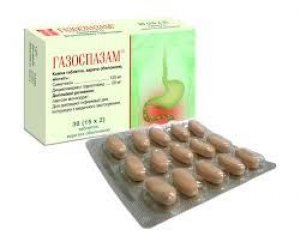
All iLive content is medically reviewed or fact checked to ensure as much factual accuracy as possible.
We have strict sourcing guidelines and only link to reputable media sites, academic research institutions and, whenever possible, medically peer reviewed studies. Note that the numbers in parentheses ([1], [2], etc.) are clickable links to these studies.
If you feel that any of our content is inaccurate, out-of-date, or otherwise questionable, please select it and press Ctrl + Enter.
Gasospazam
Medical expert of the article
Last reviewed: 03.07.2025

The drug Gazospazam is a synthetic acetylcholine receptor blocker and is an adjuvant treatment for pain syndrome. ATX code - A03A A31. Manufacturer - Kusum Healthcare Pvt Ltd (India).
ATC classification
Active ingredients
Pharmacological group
Pharmachologic effect
Indications Gasospazam
The drug Gazospazam is used as a symptomatic agent for smooth muscle spasms and flatulence that accompany such gastrointestinal diseases as colitis, intestinal colic, irritable bowel syndrome, and spastic constipation.
As an additional symptomatic agent, Gazospazam can also be prescribed for diverticulitis, enteritis, gastritis and peptic ulcers of the stomach and duodenum.
Release form
The drug Gazospazam is available in the form of oval-shaped film-coated tablets, as well as in the form of a suspension - in 30 and 60 ml bottles with a measuring spoon.
Pharmacodynamics
The active ingredients of this drug are simethicone (125 mg per tablet) and dicyclomine hydrochloride (20 mg per tablet). The carminative simethicone is an organosilicon compound of the dimethylpolysiloxane group. Having the properties of an antifoam, simethicone changes the surface tension of gas bubbles formed in the intestine and promotes their destruction. In addition, simethicone complicates the process of gas formation itself.
Dicyclomine hydrochloride is an organic derivative of ammonia - a disubstituted ester of glycolic acid (tertiary amine). It affects the m-cholinergic receptors of the central nervous system and muscarinic receptors of muscle cells, which transmit neurosignals through heterotrimeric membrane proteins. Due to the fact that the transmission of these signals is blocked, spasms of smooth muscles and spasms of muscle tissue of internal organs, including the intestines and bladder, stop. Thus, the muscles relax, which leads to the cessation of spastic pain.
Pharmacokinetics
Simethicone, being a physiologically and chemically inert substance, is not absorbed in the body and after passing through the gastrointestinal tract is excreted unchanged.
Dicyclomine hydrochloride is rapidly distributed in tissues, almost completely bound to plasma proteins, reaching maximum concentration 1-1.5 hours after taking Gazospazam; the concentration of dicyclomine hydrochloride in plasma (after taking one tablet) is maintained for 24 hours.
The half-life of the drug in the body, during which its concentration is reduced by half, is about two hours. Almost 80% of Gazospazam is excreted from the body with urine, the rest - through the large intestine.
Dosing and administration
Gazospazam in tablet form is taken by adults and children over 12 years old, one tablet 2-3 times a day - 20 minutes before meals.
Dosage of the drug in the form of a suspension: for adults and children over 12 years old - 5-10 ml no more than 4 times a day (before or after meals). The maximum daily dose is 40 ml. Duration of administration - no more than five days.
 [ 2 ]
[ 2 ]
Use Gasospazam during pregnancy
The use of Gazospazam during pregnancy and lactation is contraindicated. It is also not used for children under 12 years of age.
Contraindications
Contraindications to the use of this drug are individual hypersensitivity to its components, ulcerative colitis, gastroesophageal reflux disease, H. pylori-associated gastritis, duodenitis, cholelithiasis, motility disorders of the stomach and duodenum, intestinal obstruction (obstruction), retroperitoneal fibrosis, as well as liver and urinary tract pathologies caused by obstruction (obstructive chronic pancreatitis, hydronephrosis, neurogenic dysfunction of the bladder, etc.).
Side effects Gasospazam
From the side of the central nervous system, possible side effects of Gazospazam are expressed in the form of dizziness and headache, drowsiness or insomnia, general weakness, disturbances in movement and conversation. Side effects of this drug on digestion can be manifested by dry mouth, thirst, difficulty swallowing, nausea and vomiting, bloating and pain in the abdomen, loss of taste and appetite.
In addition, taking Gazospazam may cause visual impairment (pupil dilation and photophobia) and increased intraocular pressure; allergic reactions with rashes, hyperemia and itching of the skin; dysfunction of the urinary tract; abnormal heart rhythms; decreased sweating, nasal congestion, suffocation.
When taking this drug, it is not recommended to drive a car or operate potentially dangerous machinery.
 [ 1 ]
[ 1 ]
Overdose
Overdose of dicyclomine, which is part of Gazospazam, causes increased heart rate (tachycardia) and breathing, dry mouth, convulsions, and affective state. With these symptoms, it is necessary to: induce vomiting, wash out the stomach, give an adsorbent (activated carbon), and take to a medical facility.
Interactions with other drugs
Gazospazam should not be used simultaneously with anticholinergic drugs (atropine, metacinone, etc.). As a result of the interaction of Gazospazam with drugs that depress the central nervous system and drugs containing alcohol, a violation of the patient's psychophysiological state may occur. Gazospazam also distorts the therapeutic effect of atropine-like drugs and non-steroidal anti-inflammatory drugs.
 [ 3 ]
[ 3 ]
Storage conditions
Storage conditions for Gazospazam: in a dry place, protected from light and out of reach of children, at a temperature of up to +25°C.
Shelf life
The shelf life of the drug is 24 months.
Manufacturer
Attention!
To simplify the perception of information, this instruction for use of the drug "Gasospazam" translated and presented in a special form on the basis of the official instructions for medical use of the drug. Before use read the annotation that came directly to medicines.
Description provided for informational purposes and is not a guide to self-healing. The need for this drug, the purpose of the treatment regimen, methods and dose of the drug is determined solely by the attending physician. Self-medication is dangerous for your health.

